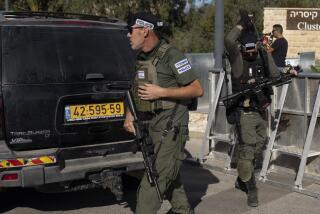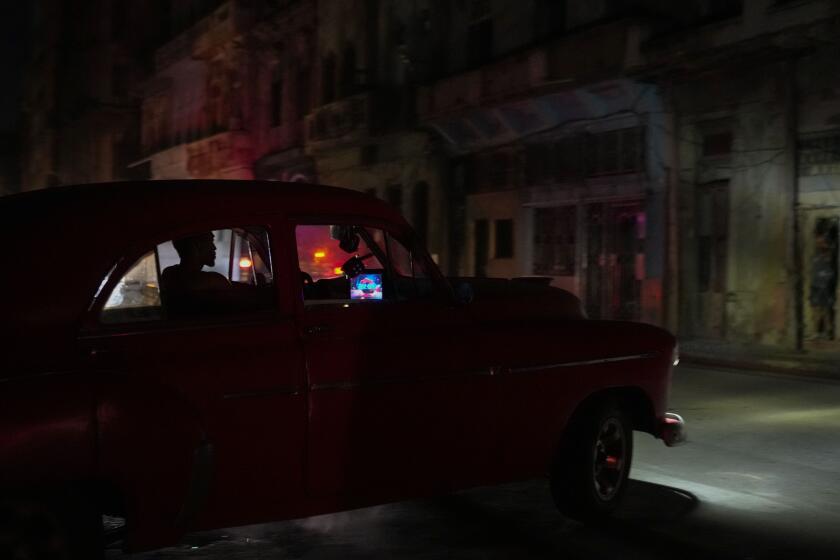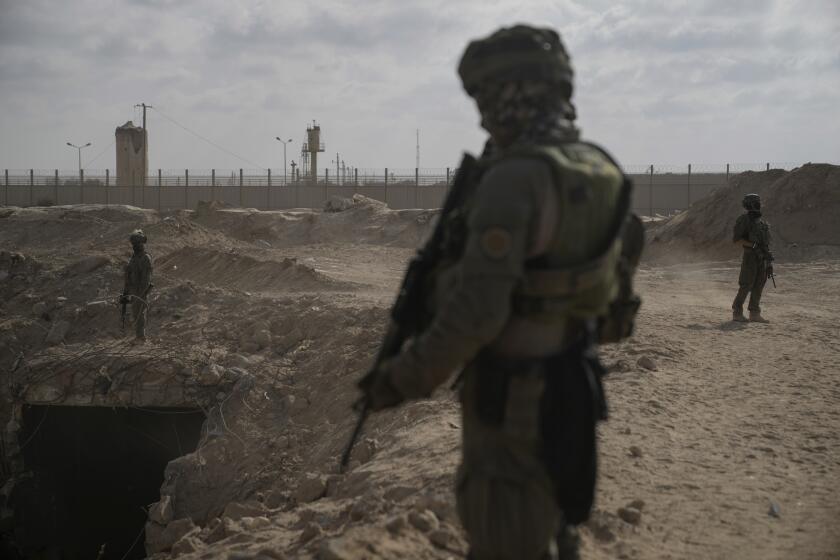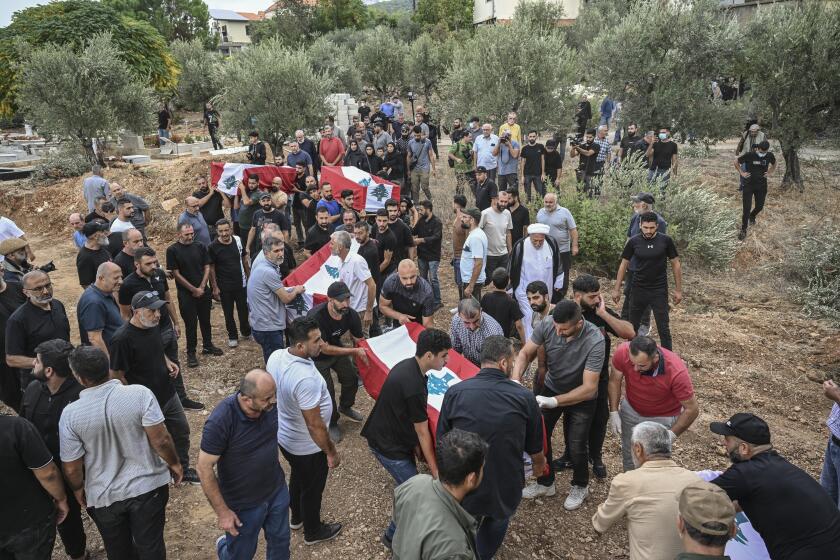Ghost Towns Stir in War-Ravaged Peru : Renewal: Peasants return, needy and fearful, to eke out a living in area ruined by guerrilla fight.
When the last people to leave Llamoctachi reached a rocky mountainside across the river from their ancestral village, they looked back to see smoke billowing into the radiant Andean sky. Their homes were on fire.
Those were times of bitter suffering and cruel drama in Peru’s south-central highlands. Between 1980 and 1992, hundreds of thousands of Peruvians fled their homes to escape a bloody and brutal war started in this region by Maoist rebels calling themselves Sendero Luminoso--Shining Path. The exodus turned many rural communities into ghost towns.
Livestock was left behind, fields went barren, rustic tools were lost, adobe houses and churches and schools were sacked or destroyed. Meager but painstakingly accumulated wealth that families and communities depended upon for survival went up in smoke.
Sendero’s back is broken now--police captured its key leaders in 1992 and the guerrilla movement has since languished, although some rebels struggle to carry on, mainly in the eastern lowlands. Peace has returned to the highlands, but a new kind of drama is unfolding here as people come back to places like Llamoctachi in a swelling human tide.
The ragtag returnees face critical scarcities and heartbreaking hardships as they start over--struggling to scratch a living from a rugged landscape that was among South America’s poorest areas even before the devastating Sendero war.
Their developing saga bespeaks an age-old truth: Those who pay most dearly for war--even after the guns fall silent--often are poor civilians caught haplessly in the middle of the conflict.
These days life is returning, like green sprouts after a brush fire, to village after war-torn village along the once-perilous Cachi River Valley northwest of Ayacucho, a state capital 200 miles southeast of Lima. But loss, desperate need and unconquered fear hang in the air like lingering smoke.
Men in most towns have formed self-defense committees to guard against guerrillas who are no longer seen but still are feared to be lurking nearby. Demetrio Saavedra, secretary of the committee in Llamoctachi, says the village has five government-issued shotguns but is asking the army for more in case Sendero returns.
Saavedra, 33, a wiry man with a sparse mustache and a Winchester slung from his shoulder, stands in the shade of a pepper tree at the center of the new Llamoctachi, reduced to a collection of tiny cane huts with corrugated metal roofs. The huts are scattered over a tilted bench of dusty ground at the foot of a parched mountain that bristles with patches of cactus and scrub.
Sendero patrols first started coming to the village in 1982, Saavedra recalls. “They pressured us to belong to them and collaborate,” he says, adding that they killed the village president and five other uncooperative residents.
The army would also come through, hunting guerrillas and collaborators.
Saavedra was in the last group to abandon Llamoctachi, in 1984. They fled with little more than the clothes on their backs as guerrillas closed in. “When we left, they burned the houses,” he says, pointing to an eroded ridge across the river.
The people of Llamoctachi began returning late last year, building makeshift dwellings with cane from the riverbank. According to Saavedra, Llamoctachi’s population before villagers began fleeing was less than 200, but many mothers have returned with children born while they were away. Now there are about 250 people crowded into 50 huts, which offer little protection from the nighttime chill.
“This is no way to live. . . .” Saavedra says. “As you see, we are suffering from the cold, with a lot of children.”
Listening villagers nod in solemn agreement as they swat at tiny “bloodsucker flies,” whose bites raise stinging welts.
The village has asked the government for aid to build better homes, but none has come. A government food program does deliver provisions for a community kitchen, and the Agriculture Ministry has loaned Llamoctachi a tractor for a couple of weeks, but villagers complain that the help is insufficient.
Many villagers have been farming carrots and other produce on the best land along the river, but they are trespassing on an abandoned hacienda. The hacienda’s owner sent his son recently to reclaim the land. “He wants to kick us all out,” Saavedra says.
Upriver the next day, in the village of Laramati, three women by an open fire heat a kettle of water for a community-kitchen meal. Delfina Vasquez says the village would starve without government-supplied beans, rice, potatoes and other provisions. Only a few of the 80 people now living in Laramati have been back longer than 10 months. The prewar population was 180.
“This year there was no planting because there wasn’t enough rain,” says Vasquez, 43, the mother of six children. Victor Vasquez, her brother, adds that Laramati also lacks seed and plows.
“We are still suffering because we don’t have anything to feed animals. There is no grass,” says Victor, 48, whose bearded cheek bulges with a wad of coca leaf that he chews like tobacco.
“Before, we had tools, and oxen too,” he says. “But we left them behind, and we lost everything.”
Still, more returnees keep arriving The community kitchen’s kettle is no longer big enough, says Delfina. “We need utensils and plates. . . . There are more people all the time.”
Warm clothes and blankets are also needed, she says. “The children get cold.”
A few skinny goats wander among the rocks and scrub at the edge of the village’s dilapidated adobe houses, which cluster around a new government health clinic. Villagers built the clinic with government-supplied concrete blocks. A nurse comes once a week, but “there is no medicine, no equipment, nothing,” Vasquez says.
Laramati now is building a new school. The old one was partly destroyed by Sendero raiders, whose graffito is still faintly legible on a crumbling adobe wall: “Long Live the Guerrilla Army.” The one remaining schoolroom is being used for classes, but they go up only to the third grade.
Across the river, in the village of Saccsa, the school is still closed. Only 20 of the village’s original 80 residents have come back to stay. Some come and go, planting small crops, returning periodically to cultivate and harvest them.
Estela Naccha, 41, has been here for a year and a half, but her two youngest children are still attending school in Ayacucho, where they live with a family friend. Naccha, who is single, lives with her two older children, 9 and 12. They have to hike several miles to school in another town.
In Ayacucho, Naccha made a living peddling potatoes. Here she survives on government food and a few animals--chickens, goats and a cow. She’s poorer here, but it’s her home and she wants to stay.
Will she? “I don’t know yet,” she says. “We are afraid. That’s why a lot of people haven’t come back.”
Searing memories from the Sendero war still burn in the minds of many. Since the Sendero launched its armed campaign not far from here in 1980, political violence in Peru has killed about 30,000 people, mostly civilians, and sent an estimated 600,000 people fleeing, mostly from poor rural areas.
Roughly 80% of the refugees left homes in the south-central states of Ayacucho, Huancavelica, Apurimac and Junin. Almost half of the south-central region’s population was displaced at one time or another.
Many thousands of Peruvians displaced by war will never return to impoverished rural areas because they have carved out better lives in provincial towns and bigger cities, including Lima, where they swell grimy shantytowns on city outskirts. But for many others, the grinding poverty in city slums has been as oppressive as the rural kind they left behind.
According to Oscar Galdo, chief of a government aid agency called the Program to Support Repopulation, an estimated 120,000 to 150,000 displaced people have returned home in the past three years.
“The city environment was too hard,” Galdo says.
His program’s task is to coordinate the efforts of different ministries and agencies to distribute food and materials, and to build new schools, first-aid clinics, silos, roads, bridges and irrigation ditches. A total of $73 million is budgeted this year for the four states of the south-central highlands, Galdo says.
Betty Olavo, who works with Galdo in the agency’s Lima office, says available funds are not nearly enough. She estimates that at least $700 million is needed for a six-year redevelopment program in the south-central region.
“Conditions must be created so that the return is permanent,” Olavo says. Officials hope international aid will be available for the program. They fear that if rural conditions are not improved, the return process will stagnate and many returnees will have no choice but to leave again.
Gilmer Garcia, whose non-governmental organization works with those going home, criticizes the government for doing little.
“Most of the people who have returned have done it without any help,” he says. “The government encourages the return but without any kind of planning.”
The recently established Program to Support Repopulation exists mainly on paper and has provided little concrete aid, Garcia says. He says members of the agency have told him privately that funds budgeted for the program were drained by a costly border conflict between Peru and Ecuador that broke out in January.
While aid is scarce, the returnees have come back with some special assets of their own. One is new links to the cities where they took refuge, through relatives and friends who are still there. Some returnees are maintaining their urban bases, constantly moving back and forth. Aid officials say those links will be useful for raising capital to invest in farming and for marketing produce.
Jaime Galdos, Ayacucho coordinator of a private aid organization known by the acronym Ceprodep, says it is working with returnees to increase their capacity for producing more cash crops and learning how to market them to better advantage.
“They are starting to realize that they have to fight for a market share,” Galdos says. He says experience in cities has made poor, uneducated peasants more open to such concepts for improving their lives, and less prone to exploitation by large landowners and produce middlemen.
And the Sendero war has taught them that change is possible. “They have seen hacienda owners take off running,” he says. “This phenomenon has shaken the old power structure. It has put it in check.”
Isabel Coral, the Lima-based president of Ceprodep, says communities with new aspirations and attitudes will be less resigned to their traditional poverty. And because the poverty is worse than before, Coral says, the highlands may be more susceptible than ever to conflict and violence. “If the state doesn’t invest,” she says, “it means that conflicts between the state and the society will arise.”
More to Read
Sign up for Essential California
The most important California stories and recommendations in your inbox every morning.
You may occasionally receive promotional content from the Los Angeles Times.









